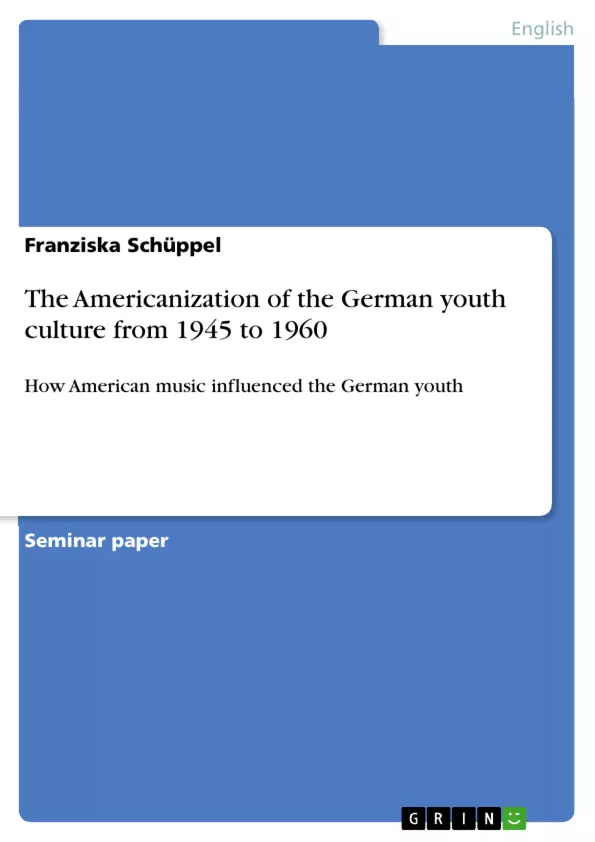1. Introduction
2. Jazz
2.1 Beginnings in East and West Germany after 1945
2.2 Two primary types of Jazz in Germany
2.2.1 Mainstream Jazz
2.2.2 Modern Jazz
3. Differences in handling Jazz between East and West Germany from 1945 to 1960
3.1 East Germany
3.1.1 State Campaigns against Jazz
3.1.2 Adolescent Jazz culture despite prohibitions
3.2 West Germany
3.2.1 Openness for Jazz
3.2.2 Jazz clubs
4. Rock ‘n’ Roll
4.1 Beginnings in East and West Germany after 1945
4.2 Influences and effects on the German youth
4.2.1 Subculture “Halbstarke"
4.2.2 Elvis Presley
5. Differences in handling Rock 'n' Roll between East and West Germany from
1945 to 1960
5.1 East Germany
5.1.1 Ways of prohibition
5.1.2 Lipsi
5.2 West Germany
5.2.1 Initial skepticism
5.2.2 Openness for Rock 'n' Roll
6. Conclusion
7. Works Cited
Inhaltsverzeichnis (Table of Contents)
- Introduction
- Jazz
- Beginnings in East and West Germany after 1945
- Two primary types of Jazz in Germany
- Mainstream Jazz
- Modern Jazz
- Differences in handling Jazz between East and West Germany from 1945 to 1960
- East Germany
- State Campaigns against Jazz
- Adolescent Jazz culture despite prohibitions
- West Germany
- Openness for Jazz
- Jazz clubs
- East Germany
- Rock 'n' Roll
- Beginnings in East and West Germany after 1945
- Influences and effects on the German youth
- Subculture "Halbstarke"
- Elvis Presley
- Differences in handling Rock 'n' Roll between East and West Germany from 1945 to 1960
- East Germany
- Ways of prohibition
- Lipsi
- West Germany
- Initial skepticism
- Openness for Rock 'n' Roll
- East Germany
Zielsetzung und Themenschwerpunkte (Objectives and Key Themes)
This work explores the Americanization of German youth culture from 1945 to 1960, specifically focusing on the influence of American music. The study analyzes the different ways in which Jazz and Rock 'n' Roll emerged and developed in both East and West Germany, considering the political and social contexts of each.- The impact of American music on German youth culture
- The differences in the reception and handling of Jazz and Rock 'n' Roll between East and West Germany
- The emergence of youth subcultures, such as the "Halbstarke" in West Germany
- The role of the state in controlling cultural expressions in East Germany
- The evolution of Jazz and Rock 'n' Roll from underground movements to mainstream acceptance
Zusammenfassung der Kapitel (Chapter Summaries)
The first chapter provides an introduction to the topic, setting the stage for the subsequent analysis of American music's influence on German youth culture. Chapter two examines the history of Jazz in both East and West Germany following World War II, focusing on its emergence as a new musical form and its development into two main categories: mainstream Jazz and modern Jazz. Chapter three delves into the contrasting approaches to Jazz in East and West Germany. In East Germany, the state actively campaigned against Jazz, viewing it as a subversive Western influence. However, adolescent youth continued to embrace Jazz, developing their own underground culture. In West Germany, Jazz received a more open reception, leading to the establishment of numerous jazz clubs. Chapter four focuses on the rise of Rock 'n' Roll in both East and West Germany, exploring its origins and its impact on German youth. The chapter analyzes the emergence of the "Halbstarke" subculture, a group of rebellious youths heavily influenced by Rock 'n' Roll, and the enduring popularity of Elvis Presley. Chapter five investigates the differences in the reception and handling of Rock 'n' Roll in East and West Germany. In East Germany, the state actively sought to suppress Rock 'n' Roll, using various methods of prohibition, while West Germany witnessed a more complex response, characterized by initial skepticism followed by a gradual embrace of the genre.Schlüsselwörter (Keywords)
The key concepts of this work are: Americanization, youth culture, Jazz, Rock 'n' Roll, East Germany, West Germany, political control, cultural influence, youth subcultures, "Halbstarke," Elvis Presley. This analysis examines the complex interplay between these themes in shaping the cultural landscape of postwar Germany.- Quote paper
- Franziska Schüppel (Author), 2010, The Americanization of the German youth culture from 1945 to 1960, Munich, GRIN Verlag, https://www.grin.com/document/207025




